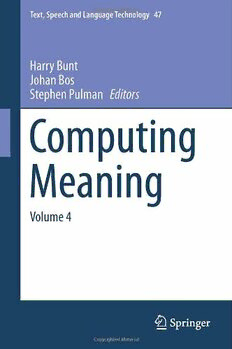
Computing Meaning: Volume 4 PDF
Preview Computing Meaning: Volume 4
Computing Meaning TEXT,SPEECHANDLANGUAGETECHNOLOGY VOLUME47 SeriesEditor NancyIde,VassarCollege,NewYork,USA EditorialBoard EmilyM.Bender,UniversityofWashington,Washington,USA MonaDiab,ColumbiaUniversity,NewYork,USA PascaleFung,TheHongKongUniversityofScienceandTechnology, Kowloon,HongKongSAR RobertoNavigli,SapienzaUniversityofRome,Rome,Italy VirachSornlertlamvanich,NECTEC,Bangkok,Thailand FeiXia,UniversityofWashington,Washington,USA Forfurthervolumes: www.springer.com/series/6636 Harry Bunt (cid:2) Johan Bos (cid:2) Stephen Pulman Editors Computing Meaning Volume 4 Editors HarryBunt StephenPulman TilburgCenterforCognition DepartmentofComputerScience &Communication OxfordUniversity TilburgUniversity Oxford,UK Tilburg,TheNetherlands JohanBos CenterforLanguageandCognition(CLCG) RijksuniversiteitGroningen Groningen,TheNetherlands ISSN1386-291X Text,SpeechandLanguageTechnology ISBN978-94-007-7283-0 ISBN978-94-007-7284-7(eBook) DOI10.1007/978-94-007-7284-7 SpringerDordrechtHeidelbergNewYorkLondon LibraryofCongressControlNumber:99056948 ©SpringerScience+BusinessMediaDordrecht2014 Thisworkissubjecttocopyright.AllrightsarereservedbythePublisher,whetherthewholeorpartof thematerialisconcerned,specificallytherightsoftranslation,reprinting,reuseofillustrations,recitation, broadcasting,reproductiononmicrofilmsorinanyotherphysicalway,andtransmissionorinformation storageandretrieval,electronicadaptation,computersoftware,orbysimilarordissimilarmethodology nowknownorhereafterdeveloped.Exemptedfromthislegalreservationarebriefexcerptsinconnection with reviews or scholarly analysis or material supplied specifically for the purpose of being entered and executed on a computer system, for exclusive use by the purchaser of the work. Duplication of this publication or parts thereof is permitted only under the provisions of the Copyright Law of the Publisher’slocation,initscurrentversion,andpermissionforusemustalwaysbeobtainedfromSpringer. PermissionsforusemaybeobtainedthroughRightsLinkattheCopyrightClearanceCenter.Violations areliabletoprosecutionundertherespectiveCopyrightLaw. Theuseofgeneraldescriptivenames,registerednames,trademarks,servicemarks,etc.inthispublication doesnotimply,evenintheabsenceofaspecificstatement,thatsuchnamesareexemptfromtherelevant protectivelawsandregulationsandthereforefreeforgeneraluse. Whiletheadviceandinformationinthisbookarebelievedtobetrueandaccurateatthedateofpub- lication,neithertheauthorsnortheeditorsnorthepublishercanacceptanylegalresponsibilityforany errorsoromissionsthatmaybemade.Thepublishermakesnowarranty,expressorimplied,withrespect tothematerialcontainedherein. Printedonacid-freepaper SpringerispartofSpringerScience+BusinessMedia(www.springer.com) Contents ComputingMeaning:Annotation,Representation,andInference . . . . 1 HarryBunt,JohanBos,andStephenPulman PartI SemanticRepresentationandCompositionality Deterministic Statistical Mapping of Sentences to Underspecified Semantics . . . . . . . . . . . . . . . . . . . . . . . . . . . . . . . . 13 HiyanAlshawi,Pi-ChuanChang,andMichaelRinggaard AFormalApproachtoLinkingLogicalFormandVector-SpaceLexical Semantics . . . . . . . . . . . . . . . . . . . . . . . . . . . . . . . . 27 DanGarrette,KatrinErk,andRaymondMooney AnnotationsthatEffectivelyContributetoSemanticInterpretation . . 49 HarryBunt ConcreteSentenceSpacesforCompositionalDistributionalModels ofMeaning . . . . . . . . . . . . . . . . . . . . . . . . . . . . . . . 71 EdwardGrefenstette,MehrnooshSadrzadeh,StephenClark, BobCoecke,andStephenPulman PartII InferenceandUnderstanding RecognizingTextualEntailmentandComputationalSemantics . . . . . 89 JohanBos Abductive Reasoningwith a Large KnowledgeBase for Discourse Processing . . . . . . . . . . . . . . . . . . . . . . . . . . . . . . . . 107 EkaterinaOvchinnikova,NiloofarMontazeri,TheodoreAlexandrov, JerryR.Hobbs,MichaelC.McCord,andRutuMulkar-Mehta NaturalLogicandNaturalLanguageInference . . . . . . . . . . . . . . 129 BillMacCartneyandChristopherD.Manning DesigningEfficientControlledLanguagesforOntologies . . . . . . . . 149 CamiloThorne,RaffaellaBernardi,andDiegoCalvanese v vi Contents PartIII SemanticResourcesandAnnotation AContext-ChangeSemanticsforDialogueActs. . . . . . . . . . . . . . 177 HarryBunt VerbNetClassAssignmentasaWSDTask . . . . . . . . . . . . . . . . 203 SusanWindischBrown,DmitriyDligach,andMarthaPalmer AnnotationofCompositionalOperationswithGLML . . . . . . . . . . 217 JamesPustejovsky,AnnaRumshisky,OlgaBatiukova,and JessicaL.Moszkowicz IncrementalRecognitionandPredictionofDialogueActs . . . . . . . . 235 VolhaPetukhovaandHarryBunt Index . . . . . . . . . . . . . . . . . . . . . . . . . . . . . . . . . . . . . 257 Contributors TheodoreAlexandrov UniversityofBremen,Bremen,Germany HiyanAlshawi Google,MountainView,CA,USA Olga Batiukova Department of Spanish Philology, Autonomous University of Madrid,Cantoblanco,Madrid,Spain RaffaellaBernardi UniversityofTrento,Trento,Italy JohanBos CenterforLanguageandCognition(CLCG),UniversityofGroningen, Groningen,TheNetherlands SusanWindischBrown UniversitadegliStudidiFirenze,Florence,Italy HarryBunt TilburgCenterforCognitionandCommunication(TiCC)andDepart- mentofPhilosophy,TilburgUniversity,Tilburg,TheNetherlands DiegoCalvanese FreeUniversityofBozen-Bolzano,Bolzano,Italy Pi-ChuanChang Google,MountainView,CA,USA StephenClark ComputerLaboratory,UniversityofCambridge,Cambridge,UK BobCoecke DepartmentofComputerScience,OxfordUniversity,Oxford,UK Dmitriy Dligach Boston Children’s Hospital, Harvard Medical School, Boston, MA,USA KatrinErk UniversityofTexasatAustin,Austin,USA DanGarrette UniversityofTexasatAustin,Austin,USA Edward Grefenstette Department of Computer Science, Oxford University, Ox- ford,UK JerryR.Hobbs InformationSciencesInstitute,UniversityofSouthernCalifornia, MarinadelRey,CA,USA BillMacCartney StanfordUniversity,Stanford,CA,USA vii viii Contributors ChristopherD.Manning StanfordUniversity,Stanford,CA,USA MichaelC.McCord Ossining,NY,USA Niloofar Montazeri Information Sciences Institute, University of Southern Cali- fornia,MarinadelRey,CA,USA RaymondMooney UniversityofTexasatAustin,Austin,USA Jessica L. Moszkowicz Department of Computer Science, Brandeis University, Waltham,MA,USA Rutu Mulkar-Mehta San Diego Supercomputer Center, University of California inSanDiego,LaJolla,CA,USA Ekaterina Ovchinnikova Information Sciences Institute, University of Southern California,MarinadelRey,CA,USA Martha Palmer Department of Linguistics, University of Colorado at Boulder, Boulder,CO,USA VolhaPetukhova DepartmentofSpokenLanguageSystems,SaarlandUniversity, Saarbrücken,Germany Stephen Pulman Department of Computer Science, Oxford University, Oxford, UK JamesPustejovsky DepartmentofComputerScience,BrandeisUniversity,Waltham, MA,USA MichaelRinggaard Google,Aarhus,Denmark AnnaRumshisky DepartmentofComputerScience,UniversityofMassachusetts, Lowell,MA,USA;ComputerScienceandArtificialIntelligenceLaboratory,Mas- sachusettsInstituteofTechnology,Cambridge,MA,USA MehrnooshSadrzadeh SchoolofElectronicEngineeringandComputerScience, QueenMaryUniversityofLondon,London,UK CamiloThorne FreeUniversityofBozen-Bolzano,Bolzano,Italy Computing Meaning: Annotation, Representation, and Inference HarryBunt,JohanBos,andStephenPulman Abstract Thischapterintroducesthesubsequentchaptersinthebookandhowthey arerelated,againstthebackgroundofadiscussionofthenatureandthecomplex- ity of processes that compute the meanings of natural language expressions. The discussion focuses on three aspects of the computation of meanings that play an important part in later chapters: (1) the nature of meaning representations; (2) the integration of inferencing with compositional interpretation; and (3) the construc- tionofsemanticallyannotatedcorporaandtheiruseinmachinelearningofmeaning computation. 1 Introduction Whilecomputersareverygoodatcomputingingeneral,theyarenotverygoodat computingmeaning.Thereareatleastthreereasonswhythismaybeso:(R1)the very notion of meaning, as expressed in natural language, is something extremely complex,andthereforedifficulttocompute;(R2)theprocessofcomputingmean- ings is extremelycomplex,because it requires the effective use of a variety of ex- tremely rich information sources (linguistic knowledge, general knowledge of the world,specificknowledgeofthedomainofdiscourse,knowledgeofinteractiveset- tings, ...); and (R3) the very notion of meaning is not well enough understood to H.Bunt(B) TilburgCenterforCognitionandCommunication(TiCC)andDepartmentofPhilosophy,Tilburg University,P.O.Box90153,5000LETilburg,TheNetherlands e-mail:[email protected] J.Bos CenterforLanguageandCognition(CLCG),UniversityofGroningen,Groningen, TheNetherlands e-mail:[email protected] S.Pulman DepartmentofComputerScience,OxfordUniversity,Oxford,UK e-mail:[email protected] H.Buntetal.(eds.),ComputingMeaning,Text,SpeechandLanguageTechnology47, 1 DOI10.1007/978-94-007-7284-7_1, ©SpringerScience+BusinessMediaDordrecht2014
